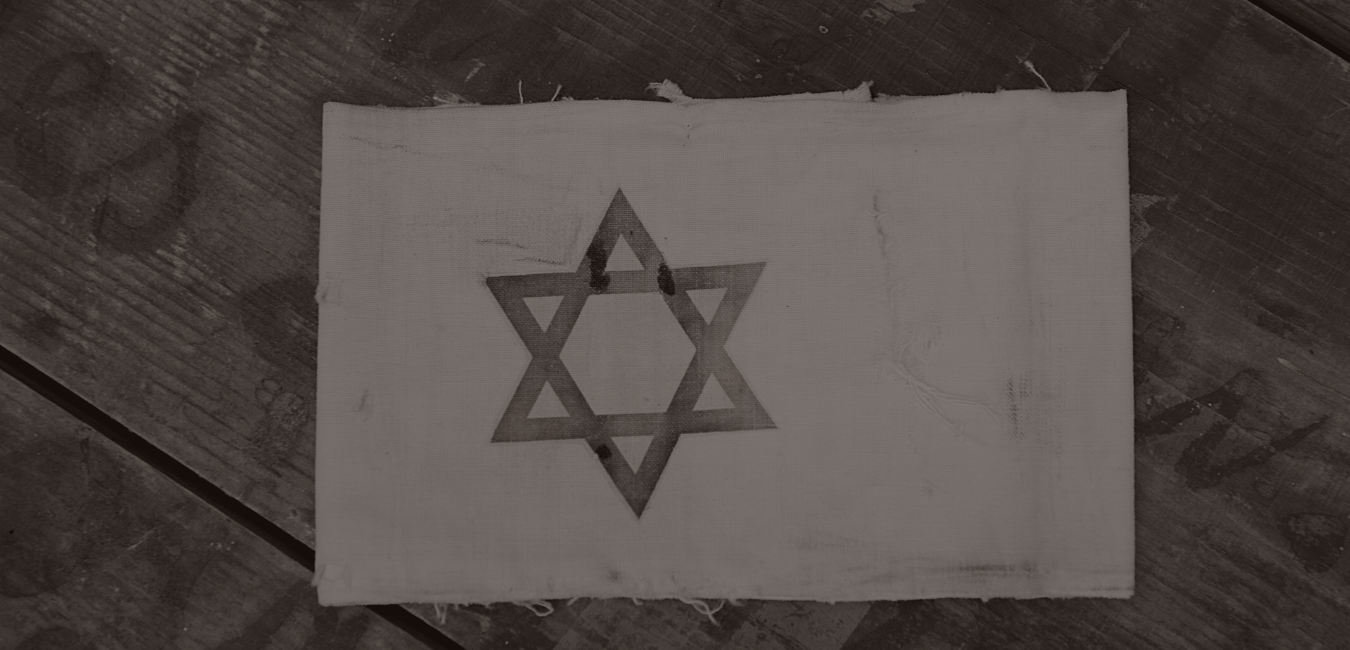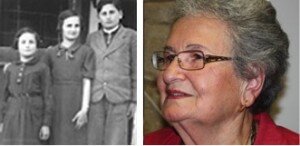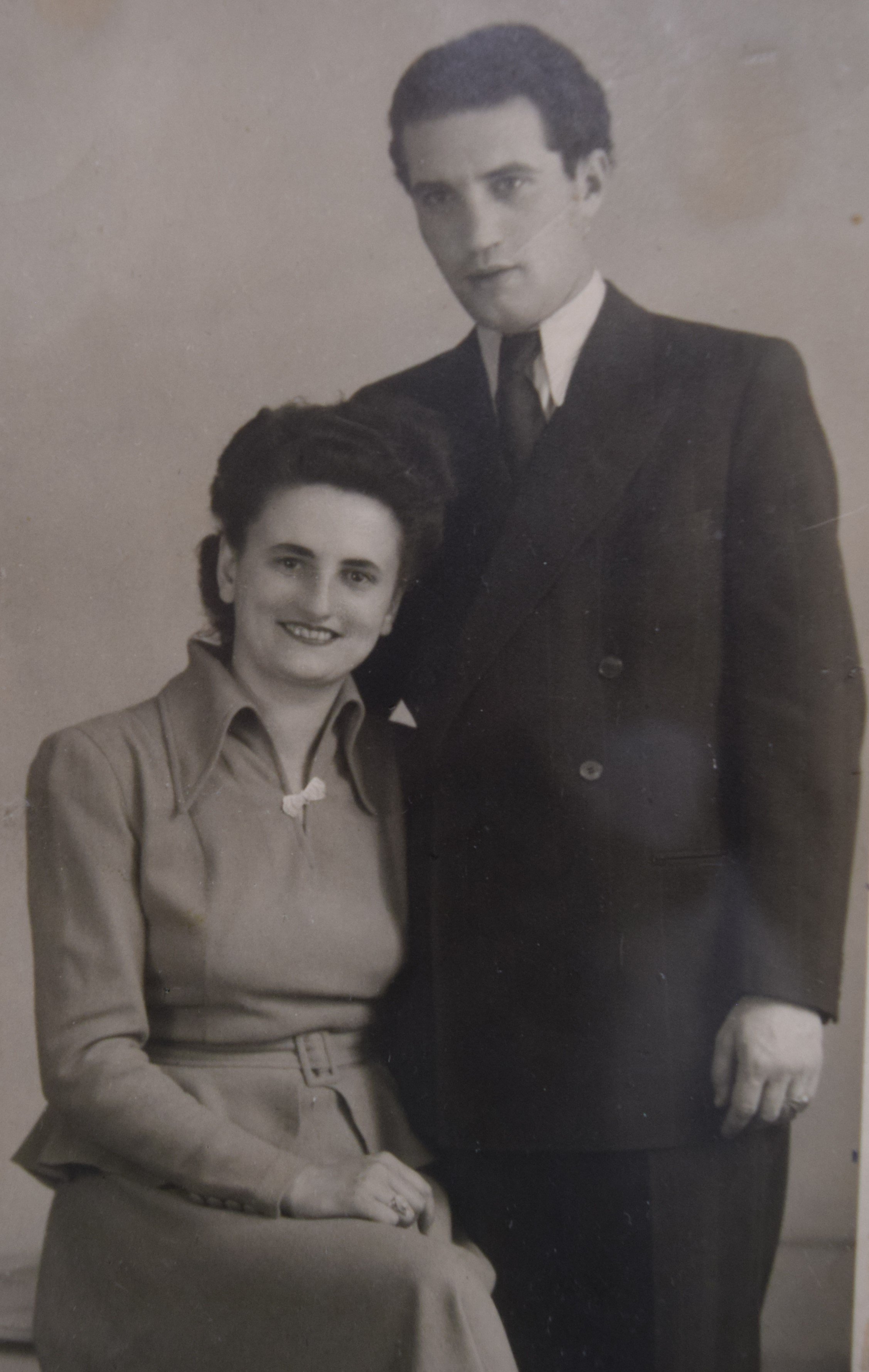
Explore an Online Feature of a Local Survivor
With our interactive feature meant to accompany the book, Letters to Rose: A Holocaust Memoir With Letters of Impact and Inspiration from the Next Generation,
learn about the life of local Holocaust Survivor Rose Williams.

Anna Levit
Anna Levit was born in Poland. She was put into the Vilno Ghetto in Lithuania and then was sent to concentration camps in Latvia and Germany. As the British liberators approached Stutthoff, the prisoners were put on barges into the Baltic Sea and abandoned. Her father and three brothers were killed by the Nazis, only she and her mother survived in Europe. After the war, she joined her sister who had previously immigrated to Mexico and came to San Antonio in 1949.
Anna is now deceased but, her daughter speaks to groups for the museum to tell her survival experience as a Second Generation speaker.
Anna Weisz Rado
Anna Rado was born in Rajka, Hungary that is a small town near the border of what was then Czechoslovakia. Her family consisted of her parents and a brother and sister. Anna’s father owned two butcher shops—one kosher and one non-kosher. On March 10, 1944, the Nazis marched into Hungary and changed Anna’s life forever.
Anna was first sent to live in a ghetto and from there the family was deported by train to Auschwitz. When they arrived at the concentration camp, her parents were separated from her and her sister. It was the last time she saw them alive. Anna was taken from Auschwitz to work in a factory in Gebhardsdorf, Germany which seemed like paradise compared to life in Auschwitz and then to a munitions factory in Georgenthal. She was liberated by Russian troops when she was 14 years old.
Anna and her family, along with her brother and his family, came to live in San Antonio, Texas in 1957 where they were reunited with their sister Susanne Jalnos who is also a Holocaust survivor.
Anna passed away in November 2022.
David and Golda Scharff
David was born in Poland and served in the Polish Army. He was captured by the Germans and sent back to the ghetto at his hometown. The ghetto was emptied and he was sent to Auschwitz. From Auschwitz, he went to a slave labor camp. When near death, he requested to be sent back to Auschwitz. He was returned in a van with approximately 15 dead bodies. When he arrived, he was still alive and recovered enough to function again. As the Russians approached, he was on a death march and escaped. He hid in the countryside and survived by posing as a Polish peasant.
David and Golda met in the D.P. Camp after the war. Golda was born in Galicia. She was in the ghetto and worked as a servant at the S.S. Headquarters. A German officer took a liking to her and managed to have her hidden as a Catholic in a monastery until the end of the war. They were the only members of their respective families to survive.
Both David and Golda are deceased but, their daughter speaks to groups for the museum to tell their survival experiences as a Second Generation speaker.
George Fodor
George Fodor was born in Hungary. He was 12 years old when the Germans took over the country. He was in numerous concentration camps in Hungary, Austria and Czechoslovakia and was eventually liberated from Theresienstadt. His mother and sister survived, but his father perished prior to liberation. He came to the United States in 1956 at the time of the Hungarian revolution.
Photo is of George with his parents and sister.
George passed way in November 2021.
Harry Weiss
Harry Weiss was born in Romania. In 1944 he and his parents were sent to a ghetto and were later transported to Auschwitz. There he was separated from his parents and was selected for forced labor, working on German railway lines. While working he was able to escape and find refuge at a local German farmhouse until he was liberated by the American army. After the war he went to work for the Jewish underground forging travel and identification documents to allow Jewish refugees to immigrate out of Communist controlled countries. After locating his mother and helping her to immigrate to Israel, he came to the United States and found work in the textile industry.
Harry has since passed away but his daughter-in-law has volunteered to begin sharing his experience at the museum.
Ilona and Nathan Haendel
Ilona was born in Hungary and received a Swiss letter of protection. With this letter she and her family were safely sequestered. Her former maid, Janosne Oros, brought food and supplies for their survival. After a period of time the Germans refused to honor the letter of protection. Ilona was forced on a death march from Budapest to Vienna. She escaped and then hid in the home of Mrs. Oros, until the Russians liberated Budapest. Mrs. Oros’ name has been inscribed in the honor wall in the Garden of the Righteous at Yad Vashem, Jerusalem.
Nathan was born in Poland and went to Vienna to study voice. He recognized the danger lurking and went to France where he joined the Army in order to avoid deportation. After the fall of the Maginot line his entire unit was allowed to enter Switzerlnad where he remained until the end of the war.
Both Ilona and Nathan are deceased but, their daughter speaks to groups for the museum to tell their survival experiences as a Second Generation speaker.
Mathilde Schwarz Rosenblatt
Mathilde Rosenblatt grew up in Vienna, Austria living an average middle-class childhood. Her father was a jeweler until the Nazis invaded Austria in 1938. After experiencing the violence of the November Pogrom (Kristallnacht) her family moves to Poland in hopes of staying safe from Hitler’s anti-Jewish policies. However, the Nazis soon invade Poland and Mathilde and her family are sent to live in the Warsaw ghetto. Because food and resources were so scarce in the ghetto Mathilde, like many children in the ghetto, spends her nights sneaking out through the sewers to smuggle food and supplies back to her family. When she is 16 years old her family receives word from the American consulate in Vienna that they have a Visa for Mathilde to go to the United States if she can make it back to Vienna. She disguises herself, escapes from the ghetto and makes the 450-mile trip back to Vienna by herself, largely on foot, sneaking across the border without any travel papers and avoiding countless Nazi troops. Once she arrives in Vienna, she is able to collect her Visa but then must travel another 650 miles to Rotterdam, through many Nazi checkpoints, where she is able to get passage to the United States.
Mathilde is now deceased but, her son speaks to groups for the museum to tell her survival experience as a Second Generation speaker.
Oscar Ehrenberg
Oscar Ehrenberg was born in 1930 in Kosice, Czechoslovakia. Oscar and his sister Alice loved going to the movies on Saturday afternoons, it was there that they saw newsreels about the growing military strength of Germany. The Ehrenberg’s knew about the German occupation of Austria. They heard Hitler on the radio, and since they spoke German, they understood his terrifying, angry message and his hatred of the Jews. For about eight weeks, Oscar’s father was drafted into a unit of the Czech army. Oscar remembered the invasion of Poland in September of 1939 because the Germans marched past his house for two weeks with horse cavalry, infantry, bicycle troops, and armored vehicles.
Early in 1942, Mr. Ehrenberg arranged for Oscar and Alice to get to the Hungarian border because he could see that things were becoming very dangerous. After getting across the border, the children moved frequently to make them more difficult to trace. Oscar and Alice would never see their parents again; their mother was shot as she was trying to escape transport to Auschwitz, and their father died in a concentration camp. In 1944, Oscar and Alice were deported to Auschwitz. While he was in Auschwitz, Oscar was put to work in another barrack helping a political prisoner named Tadek. At the end of 1944, Tadek told Oscar that soon German SS officers would come into the boy’s barracks seeking workers for a machine factory. Tadek told Oscar that in order to survive he must get out of Auschwitz and this machine shop was the way out. Tadek trained Oscar, and then Oscar trained his friends. He and his friends were selected to work at the factory. In January 1945, Oscar was sent on a death march to Mauthausen, Austria and later Gunskirchen in upper Austria. Two to three days later, the guards fled and Oscar and his friends left the area. Oscar and his friends encountered American liberators sometime later.
Both Oscar and Alice survived the war. Oscar moved to the United States, and in 1959 he married Millie Vogel of San Antonio. They had two children. Oscar later helped establish the San Antonio Holocaust Memorial Museum and served as the President of the Jewish Federation.
Roman Lubetzky
Roman Lubetzky was born in 1930 in Riga, Latvia and moved to Kovno, Lithuania at a young age. When the Germans invaded the country in 1941, the Nazis, with the help of the Lithuanians, initiated a systematic campaign to exterminate the more than 200,000 Jews of Lithuania. By the end of the year, only 40,000 Jews remained, and they were forced into four localized ghettos.
Roman, his parents, and his older brother were forced into the Kovno Ghetto, where they remained until 1943 when the ghetto was liquidated. They spent about six months in a nearby labor camp before being shipped by cattle cars to Germany. Roman’s mother was sent to Stutthof, while her husband and sons were sent to Dachau. Roman, along with his father and brother, miraculously survived in Dachau until they were liberated by American troops in April 1945. At that time, Roman was 6 ft tall and weighed a mere 70 lbs.
After extensive recuperation, Roman emigrated to Mexico in 1947 to start a new life. He and his wife, Sonia, ultimately moved to San Antonio where they raised their family. Despite having experienced humanity in its darkest hour, Roman always believed in the power of kindness, and encouraged his four children to be courageous and compassionate individuals.
Rose Sherman Williams
Rose Williams was born in Radom, Poland. She and her 3 siblings, a younger sister and brother and an older brother along with her parents, had a lovely life in Radom. Her father owned a leather factory. When Germany invaded Poland in 1939, Rose’s life as a twelve year old was changed forever.
The Sherman family was forced to move out of their home and move into a ghetto. There the entire family lived in one room. In 1942, the ghetto was liquidated and Rose was separated from her family and sent to another town in Poland where she worked in an ammunition factory. During this time she learned that her parents perished. From there she was sent to Auschwitz where she received her tattoo. Life in Auschwitz was extremely hard for Rose. Because she had no shoes, her feet became frostbitten and full of sores. However, it was also in Auschwitz where she was reunited with her sister, Binne. Towards the end of the war, she was forced to march to Bergen-Belsen, the worst camp that Rose had witnessed. On April 15, 1945 she was liberated by British troops.
After liberation, she worked in Stuttgart, Germany until arriving in the United States.
Rose has recently published her memoir, Letters To Rose, written with Rebecca Hoag and Robin Philbrick.
Susanne Weisz Jalnos and Stephan Jalnos
Susanne Jalnos was born in Rajka, Hungary that is a small town near the border of what was then Czechoslovakia. Her family consisted of her parents and a brother and sister. Her father owned two butcher shops—one kosher and one non-kosher. On March 10, 1944, the Nazis marched into Hungary and changed her life forever.
By Passover 1944, all Jews were forced to leave their homes in Rajka and move into a ghetto in Mosonmagyaróvár, about 15 kilometers away. The family stayed in Moson only about three weeks. After that, they were moved twice, each time taking less and less with them. They had started with three wagon loads of belongings, but ended up taking only what they could carry to their third place, an attic in a larger ghetto in Gyor. Then, the Hungarian Jews in Gyor were rounded up to be deported. Several days later they arrived in Auschwitz. Susanne had been in Auschwitz six weeks when she was selected to go to a work camp in Lipstadt, in the state of Westphalia. Susanne and the others were to be working in a munitions factory.
As U.S. troops approached the area, the Germans marched the factory workers away from Lipstadt toward the Bergen-Belsen concentration camp. On March 29, 1945, Susanne and five hundred women from the factory, plus three hundred others who had joined them, began a march that lasted three nights. During the days they hid in barns to avoid detection. They eventually came to a stadium on Easter Sunday, April, 1, 1945, where local Germans were flying white flags. U.S. bombers were flying overhead, and within a short time, the Germans fled from the stadium and the town. They were liberated. Susanne married her husband Steve in 1949. They arrived in San Antonio later in the year and was later reunited with her brother and sister.
Susanne has now retired from public speaking. She continues to serve as an invaluable resource for the museum but no longer speaks to groups.
Sam Cohen
Sam grew up in a small, modest house in Salonika, Greece. Prior to World War II, Salonika had the largest Jewish community in Greece - about 50,000. Though there were instances of antisemitism leading up to the war in Salonika, the private school Sam attended protected him from much of it. By the late 1930s, citizens of Salonika knew about Nazi persecutions against the Jews. People were frightened but also passive. They never expected to be victimized. Sam grew up thinking of himself as Greek. When the war broke out in 1939, he was actually happy because he believed that France, which collapsed in a week, would defeat Hitler.
In mid-July 1942, 9,000 Jewish males, ages 18 to 45, were ordered to report to Liberty Square. They were kept there all day, suffering beatings while registering for forced-labor assignments. Sam’s name was not taken that day, but later he and his brother decided to register at a neighborhood school. When they approached the school, they saw more people being beaten. They left without registering and went back to work. When a decree mandated the rounding up of Jews for forced labor on railroad tracks outside the town, Sam was advised to tell the Nazi’s that he worked for several Germany companies, making him exempt from forced labor. Sam and his family were forced to move into the ghetto by Germans after Passover in 1943. Keeping a promise with his friend Jacques that they would stay together no matter what, Sam took the place of Jacques’ brother when the two were summoned to work forced labor. Sam and Jacques were taken to a concentration camp. The two later escaped from the camp during their daily work laying down railroad tracks and joined the resistance.
Sam moved to San Antonio, Texas from Greece in 1951 where the Jewish Federation helped him get a job as a bookkeeper and return to school. He married in 1955 and went on to have three children and eight grandchildren.
Hear Their Story
Holocaust survivors and children of Holocaust survivors may be available to present their stories to tour groups at the Museum but we can not guarantee that a speaker will be available for your tour. We no longer send survivors to speak at off campus presentations, however, we can send our museum docents as speakers.
To schedule a tour at the Museum or off campus, please complete the appropriate form below.













